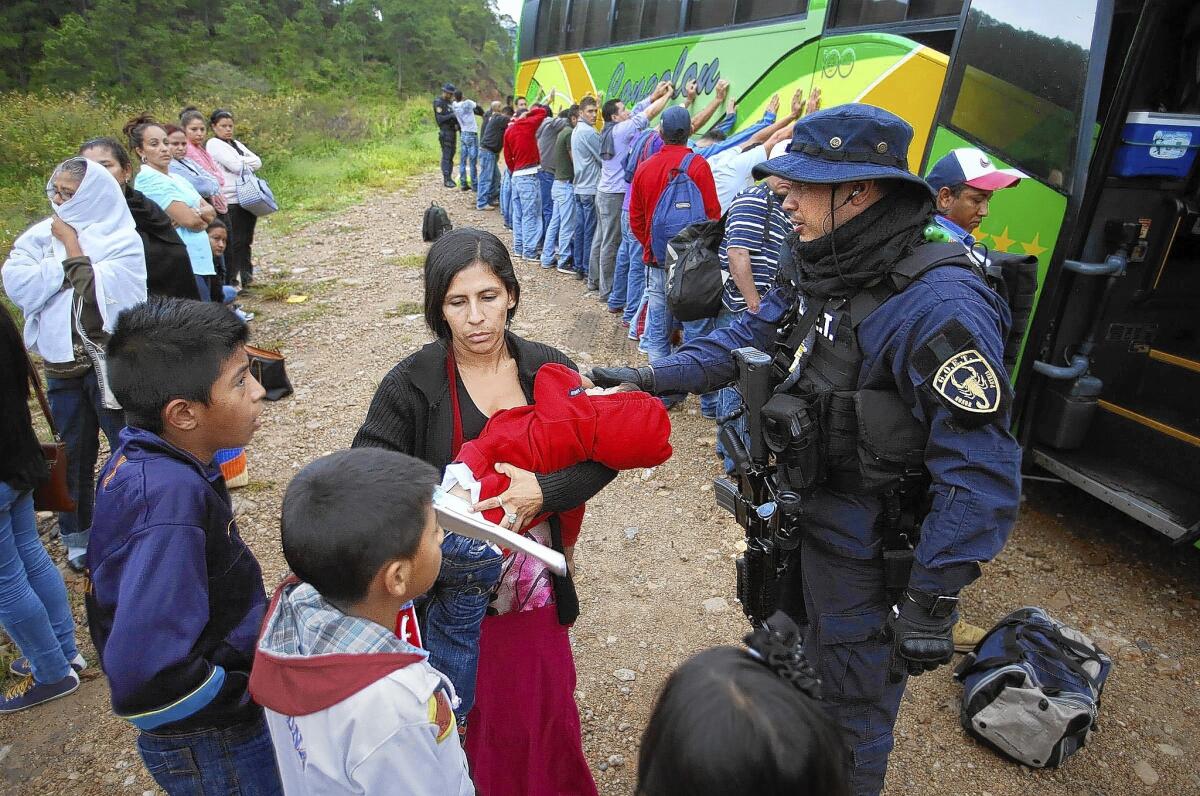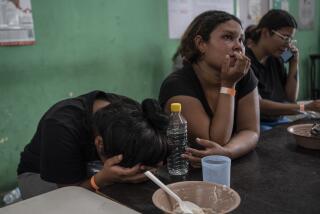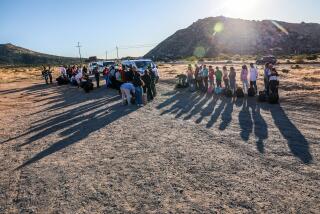Elite Honduran unit works to stop flow of child emigrants to U.S.

Reporting from OCOTEPEQUE, Honduras â Empty energy drinks and rusted baby formula cans litter the moss-covered banks of the Lempa River near this countryâs northern border, marking the trails where, until recently, migrants â some of them children â made their way into Guatemala on a treacherous journey to the United States.
Today, though, the trails are quiet except for the squawking cacophony of birds.
An elite unit of the Honduran national police, trained and funded by the United States, is making its presence felt along the border in a mission to slow down the migrant flow at its source. The team, which usually focuses on drug and arms interdiction, was deployed just as Americans awoke to a dramatic increase in the number of unaccompanied minors streaming into the United States from Central America.
âWe are saving the lives of our countryâs children,â said Noel Hernandez, a first lieutenant with the unit, the Honduran Special Tactical Operations Group.
A little more than two weeks ago, the team arrived in the verdant border town around Aguas Calientes to serve as the first line of defense in a program dubbed Operation Rescue Angels, according to Commissioner Miguel Martinez Madrid, a Honduran liaison to the U.S. Embassy in Tegucigalpa and coordinator of the special unit.
âThese are little angels. They are not conscious of the risks they are taking. We are doing something good,â said Martinez Madrid, the father of two young daughters. âThese are our children. They are the future of our country.â
According to the national police, the team is primarily funded by the U.S. State Department and was trained by a U.S. Border Patrol Tactical Unit, known as BORTAC. The teamâs aim in this operation is to stop the flow not just of unaccompanied minors, but of children who head north illegally with only one parent.
On a recent afternoon, the agents set up a checkpoint where a major highway splits toward two separate border crossings just south of the town of Ocotepeque.
Covered with bulletproof vests emblazoned with âPoliceâ and badges that read âBORTAC,â the agents waved down a late-morning bus bound for Guatemala.
Among the passengers was Ana Maria Ramos, who sighed when the unit pulled her off for questioning. She tried to keep her 2-year-old son from wandering away as she answered questions about where they were going.
She said they were bound for Los Angeles in an attempt to flee gang violence and crushing poverty back home in San Pedro Sula, the second-largest city in Honduras. The homicide rate there, the highest in the country, has led to it sometimes being called the murder capital of the world.
âI donât want my boy to grow up in such a violent environment. I donât want him to see the violence and learn it. I donât want this for my son,â she said.
She cradled the boy and explained to the agents that although she didnât have his fatherâs written authorization to leave the country, he had given his consent.
Martinez Madrid nodded but said he couldnât let her go.
âIf you are going to leave the country, you must do it legally,â he told her. The unit then took the two to lunch at a diner before handing them over to child welfare authorities in Ocotepeque.
Under the law in Honduras, as in many countries, children cannot leave without authorization from both parents. A parent attempting to leave the country with a child must have a notarized document from the absent parent authorizing the trip for the child. The child must also have a valid Honduran passport.
Unaccompanied children from Honduras and throughout Mexico and Central America, often fleeing gang violence and hoping to reunite with parents in the United States, have been entering the U.S. through the Southwest border for years. But a surge in the last few months overloaded Border Patrol stations and detention facilities in Texas.
Under fire from Republicans, including Texas Gov. Rick Perry, the White House said Monday that most of the young migrants would be deported, although it is unclear whether the administration has the legal authority to send them back.
In the last 17 days, the special Honduran unit has stopped 90 children from crossing the northern border near Aguas Calientes, some as young as 2 years old. Most are older and traveling without a parent. Martinez Madrid acknowledged that itâs a drop in a bucket. Still itâs a departure from the easy flow of illegal immigration at the border crossing before the unit showed up, he said.
About a month ago, there was a surge of children â some alone and others with their mothers â who easily traveled into Guatemala on their way farther north without proper documentation.
Honduran immigration officials largely let them leave without enforcing child-trafficking laws. Some took bribes. Others chose to simply look the other way, Martinez Madrid said.
Operation Rescue Angels is the first program of its kind in the region, he said.
Fourteen agents are stationed at the northern border near Aguas Calientes. An additional 13 are assigned to the southern border with Nicaragua but are scheduled to move farther north and set up impromptu checkpoints on a main highway just north of Tegucigalpa, the Honduran capital.
Despite the successes, Martinez Madrid said he suspects that the flow may have simply moved to other crossing points, such as the border crossing in Corinto, about a four-hour drive east from Aguas Calientes.
The checkpoints leading from San Pedro Sula and Tegucigalpa are key to stopping the flow of migration, especially since the three top municipalities sending children to the U.S. are all in Honduras, according to Pew Hispanic Center researchers who analyzed data provided by the Department of Homeland Security.
San Pedro Sula leads the list, with more than 2,200 unaccompanied minors apprehended in the United States between January and May, making up an estimated 5% of all apprehended children since Oct. 1. Following San Pedro Sula are Tegucigalpa and Juticalpa, each with more than 800 apprehended children during the same period.
The operation to stop the children had been in the works for the last three months after Honduran authorities noticed an uptick of youths leaving the country through its northern borders, National Police Director General Ramon Sabillon said.
The plan was accelerated in late May, he said, about the same time that U.S. Customs and Border Protection officials were taken aback by a sudden rush of children illegally entering the U.S. alone or with a single parent along Texasâ Rio Grande Valley.
Sabillon said he asked U.S. Embassy officials in Honduras for help and they complied.
State Department documents, however, show that special tactical units from the Border Patrol have been training Honduran border guards since at least 2012. That year, BORTAC teams taught at least five courses, each 13 weeks long, training about 100 Honduran border police officers, according to a published summary of the training. It continued in 2013 and ramped up this year.
The training was funded through a program called the Central America Regional Security Initiative. The goal of the program is to fix âborder security deficienciesâ as well as disrupt drug and weapons trafficking and organized crime, according to a State Department description.
Since 2008, the State Department has spent more than $642 million through the program in Belize, Costa Rica, El Salvador, Guatemala, Honduras, Nicaragua and Panama. It is unclear how much was used to train the Honduran forces.
A spokesman for U.S. Customs and Border Protection, Michael Friel, referred questions about the training to the State Department, which did not return multiple requests for comment.
The Honduran police unit arrived in Ocotepeque on June 20 â the same day Vice President Joe Biden met with Central American leaders in Guatemala to discuss how they could work together to address the alarming number of unaccompanied minors coming to the U.S. from Central America.
Damilo Avila Zavala, a 16-year-old traveling alone from San Pedro Sula, fit that profile. The agents pulled him off a big green bus bound for the Guatemalan border.
Avila Zavala swore to the agents that he was visiting his girlfriend in Ocotepeque and not going farther north. She is a U.S. citizen who had family in town.
He was let go after agents visited the girlfriendâs home and confirmed the boyâs story with her family.
Still, the boy acknowledged that he had tried making the illicit journey two years ago but was stopped in Chiapas, Mexico, and deported back home. He said he plans to marry his girlfriend and go to the U.S. after she sponsors him. If that doesnât work out, heâll fall back on Plan B.
Heâll go north, even if it means going illegally and alone.
Times staff writer Brian Bennett in Washington contributed to this report.
Follow @TheCindyCarcamo on Twitter
More to Read
Sign up for Essential California
The most important California stories and recommendations in your inbox every morning.
You may occasionally receive promotional content from the Los Angeles Times.











